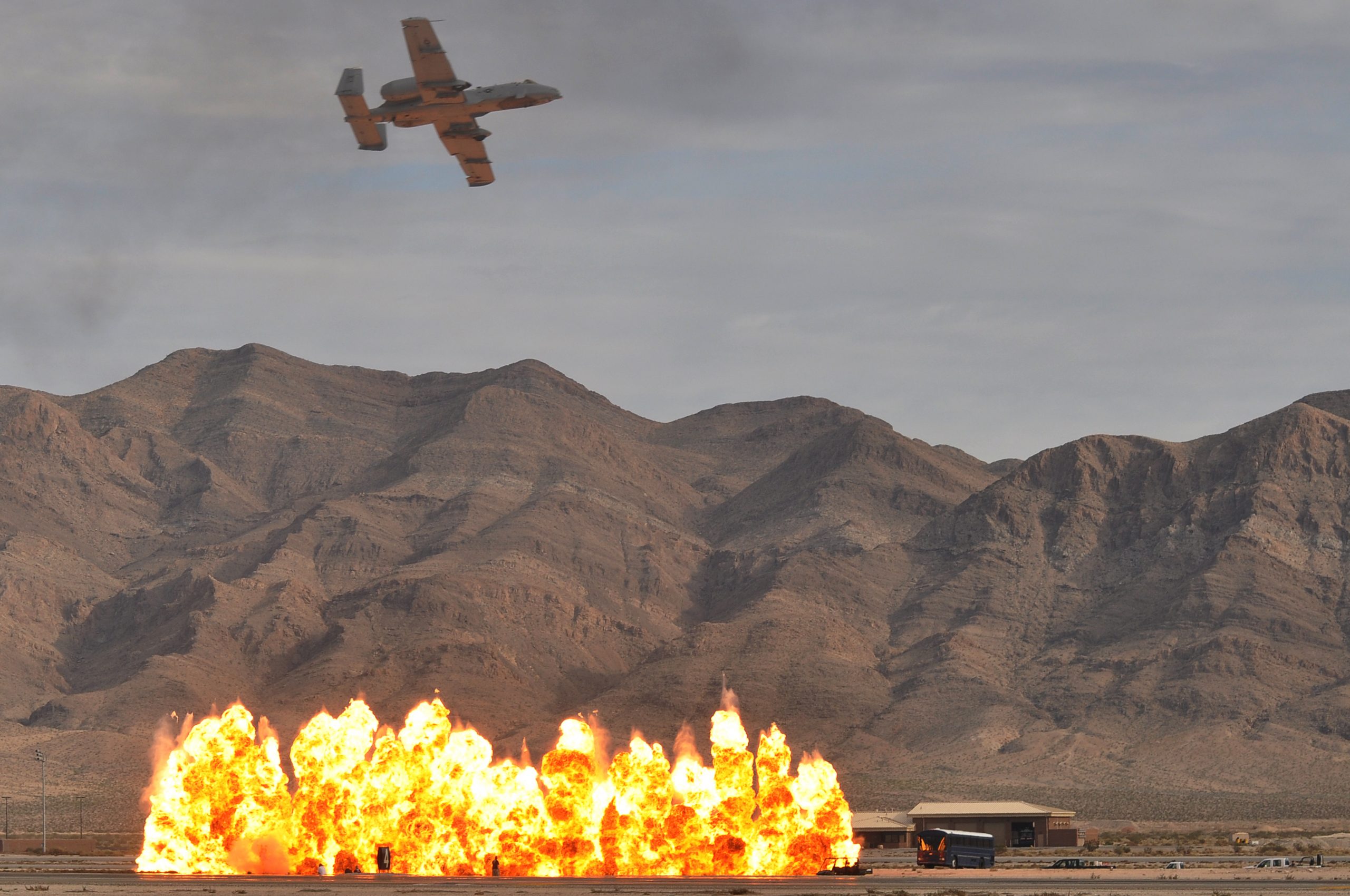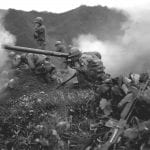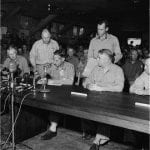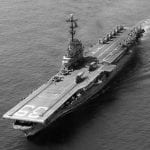The following article on Close Air Support (CAS) is an excerpt from Barrett Tillman’s book On Wave and Wing: The 100 Year Quest to Perfect the Aircraft Carrier. It is available to order now at Amazon and Barnes & Noble.
In the wake of World War Two, the value of carrier aviation was proven repeatedly, to the benefit of hard-pressed ground troops who needed close air support (CAS)—defined as air action by aircraft against hostile targets that are in close proximity to friendly forces, and which requires integration of each air mission with fire and movement of these forces.
From early August 1950, allied forces were compressed into the shrinking perimeter around Pusan, occupying barely 10 percent of South Korea’s land area. Of the U.S. Air Force’s nine fighter and medium bomber air wings available during 1950, only one remained in Korea through year-end, with another rotating in and out. Just to reach the Korean coast, Japan-based squadrons flew at least 250 miles round trip.
Thus, sea-based airpower had to take up the slack—and it did.
AIRCRAFT CARRIERS PROVIDE CLOSE AIR SUPPORT
Another intrinsic benefit of naval aviation was its institutional experience with close air support. From start to finish, 46 percent of all Navy-Marine sorties were close air support, and though slightly less than the Air Force figure, naval aviators had long experience in the doctrine and technique of close support. It was not always true of the Air Force and other allied fliers. In fact, one of the lessons learned from Korea was the importance of integrated training between air and ground forces. Sometimes Air Force pilots lacked the ability to communicate with Army infantry, and while naval aviators usually could talk to Marines, occasionally nobody could talk to the Army. USS Sicily’s (CVE-118) Captain John Thach recalled, “The pilots would come back and say, ‘We couldn’t help. We wanted to. We were there and we couldn’t get in communication with people.’”
In happy contrast, the close-knit Marine air-ground team was especially effective owing to prewar doctrine and commitment to close air support integration into infantry training.
Allied forces captured large numbers of North Korean soldiers in the 1950 battles, producing valuable intelligence. Interrogations revealed that aircraft, or fear of them, was the second greatest factor affecting enemy morale, after food shortages. The next largest factors were poor training and equipment. More directly, by September combined allied air interdiction reduced communist supplies to barely 10 percent of the June level.
The seesaw war up and down the Korean peninsula appeared headed for a conclusion toward year’s end, with vainglorious theater commander Douglas MacArthur predicting early victory. He ignored Peking’s warnings to stop well south of the Yalu and downplayed information of Chinese involvement starting in October.
Subsequently, Navy and Marine fighter bombers helped keep the massive Chinese floodtide from drowning all before it—especially during the withdrawal from Chosin Reservoir at year end. Following the Christmas evacuation from Hungnam, which ceded all of North Korea to the communists, the war settled into a stalemate.
Despite persistent, and sometimes heavy losses, there were results. Allied airpower was essential against Asia’s quilted troops streaming south from Manchuria. The Marines could not speak too highly of the close air support provided by carrier aviators during the long, frozen trek to the coast from the Chosin Reservoir in December 1950. Even Army infantrymen spoke admiringly of the short response and precision accuracy of the dark-blue Navy and Marine aircraft.
One of the war’s most remarkable events began as a close air support mission on December 4, when Leyte launched Corsairs to support Marines near Chosin Reservoir. The section leader, Lieutenant (jg) Jesse Brown, made a crash landing with flak damage to his F4U-4, but he got caught in the cockpit, unable to leave the plane. With darkness approaching, he needed immediate help.
Brown’s wingman was Lieutenant (jg) Thomas J. Hudner, who only knew that a shipmate was in trouble. Hudner dropped his flaps, kept his wheels up, and executed a belly landing on the snowy slope. Upon reaching his friend, Hudner found that Brown was injured, trapped by the buckled fuselage. Another Corsair radioed for help, and while a Marine helicopter motored inbound, Hudner continued tending to his friend.
Hudner and the helo pilot tried to chop Brown from the fuselage, to no avail. With darkness imminent, Jesse Brown lapsed into unconsciousness, and the rescuing pair had no choice but to depart. Tom Hudner received carrier aviation’s only Medal of Honor for the Korean War.
Aircrew morale and mission effectiveness were affected by rules of engagement. Truman allowed allied forces to bomb only the southern half of bridges across the Yalu River, which separates North Korea and China. Naval aviators and other allied airmen were stymied by the administration’s fear of a Chinese response, when at least 100,000 Chinese already were committed to combat.
Although carrier aviators concentrated on interdiction and close air support, they made significant contributions on a larger scale. On May 1, 1951, Skyraiders from USS Princeton (CVA-37) were tasked with holing the strategic Hwachon Dam, controlling a reservoir in the path of allied forces along the Thirty-Eighth Parallel. Bombing was ineffective so planners wanted the dam breached with aerial torpedoes to prevent the communists from releasing a deluge that could sweep all before it. Eight pilots from two of “Sweet P’s” AD-4 squadrons were selected to attack the dam. Only three had ever dropped a torpedo, but the procedure was straightforward.
Led by pipe-puffing Commander Robert Merrick, the Skyraiders were escorted by Corsairs as flak suppressors. Merrick led his torpedo men through four thousand-foot mountains, arriving over the reservoir in the required profile: 160 mph at one hundred feet off the water. The pilots’ aim was excellent, as six “fish” struck the targeted floodgates or near enough to inflict damage. With holes in both sides, the dam was rendered largely ineffective as a floodgenerating source.
Subsequent air attacks were made on Korean power generating facilities, including a campaign in the summer of 1952. Four Task Force Seventy-Seven carriers—Bon Homme Richard, Philippine Sea, Princeton, and Boxer, (CV-21)—cooperated with Air Force and Marine land-based units to strike six facilities of the Sui-ho dam complex on the Yalu River. In the first strike, on June 23, tailhookers demonstrated their proficiency by putting thirty-five Skyraiders on and off the target in about two minutes. A Corsair was shot down by flak with the pilot saved.
The two-day bombing total was 730 Air Force and Marine sorties plus 536 from carriers. The attacks reduced 90 percent of the facilities’ hydro-electric output for two weeks and reportedly deprived China of one-quarter of its electricity.
Probably the most significant of aviation’s setbacks were doctrinal. Far East Air Forces, notably Fifth Air Force, established Operation Strangle in an effort to interdict enemy supplies and communications to the battle area. “Strangle” sought to duplicate the results of the original operation in Sicily in 1943. But success eluded Allied airmen over Korea due to two factors: immunity of Chinese bases in Manchuria, and the relative simplicity of the enemy supply system. Even Task Force Seventy- Seven’s “Cherokee” strikes dividing North Korea into what a later generation would call “route packages” failed to achieve desired results. Clearly, tactical aviation could be better employed—and it was.
This article is part of our larger selection of posts about the Korean War. To learn more, click here for our comprehensive guide to the Korean War.
 |
This article on Close Air Support is an excerpt from Barrett Tillman’s book On Wave and Wing: The 100 Year Quest to Perfect the Aircraft Carrier. It is available to order now at Amazon and Barnes & Noble.
You can also buy the book by clicking on the buttons to the left.
Cite This Article
"Close Air Support (CAS): Its Korean War Origin" History on the Net© 2000-2024, Salem Media.
April 20, 2024 <https://www.historyonthenet.com/close-air-support>
More Citation Information.









